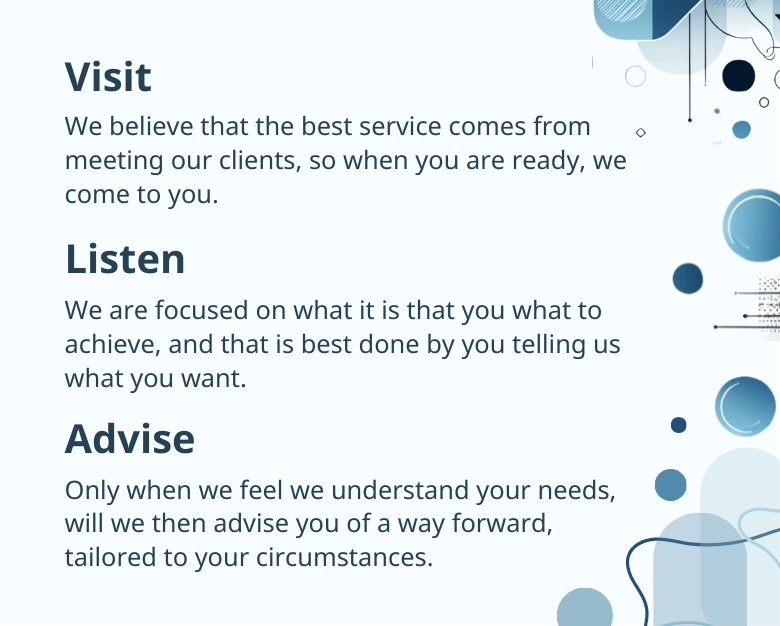What is an Equity Release Drawdown Plan?
An Equity Release Drawdown Plan, also known as a Lifetime Mortgage Drawdown Plan, is a flexible type of Equity Release Plan that lets you take cash from the equity in your home as and when you want to.
You take an initial lump sum and have an approved cash facility, often called a reserve, sitting in the background. You can ‘draw’ from the reserve when you need to, although there is never a requirement to take anymore money. The interest will only be charged on the cash you’ve actually taken, not the amount of the reserve.
Drawdowns are very popular as these plans can be more cost-effective as the interest charged can be less over time.
How much can you release?
Use our Equity Release calculator today. Quick, easy and no personal details required.
How it works
A Drawdown Equity Release Plan has all of the rules that go with Equity Release Plans such as age requirements, type of property allowed, and being a UK resident. But it offers greater flexibility about how you access your money. Here are the important points to note.
- You will agree a total amount you can take with your provider based on your age, health, and the value of your property.
- An initial amount will be taken for your immediate requirements and the remainder will be left in reserve for you to take in the future either in another chunk or in several small bites.
- There will be no further set up fees for the amounts you subsequently draw down.
- Interest is only charged on cash that has been taken. No interest is charged on what remains in the reserve account.
- The initial amount will have an interest rate that is fixed for life.
- Any subsequent drawdowns from the reserve will have a different fixed rate for life. The lender will advise what the rate is at the time. You could end up with several rates under your plan over many years.
- Lenders often restrict the maximum amount they will lend on a drawdown. This is because they have to keep the reserve capital available at short notice. This cost the lenders money, so if you think you will need a larger amount in the next few months, a drawdown plan may not be the most suitable option for you.
Advantages of a Drawdown Plan
- Flexibility to take tax-free cash at your convenience – you can take it as and when you would like to, yours to spend as you wish.
- You can manage your means-tested benefits – by taking smaller amounts at the appropriate times, you can help avoid disqualifying your entitlement to state benefits. As with all means tested benefits, you are advised to consult the Benefits Agency and your local authority in order to stay withing the rules.
- Interest doesn’t grow as quickly as taking a larger lump sum and depositing the excess in a bank account. Interest on a Lifetime mortgage will be compounded and always be more expensive than interest gained in a deposit account.
- After the initial amount, some drawdowns allow you to take from as little as £500. The majority are £2,000 so can be very flexible to meet your immediate needs. You will only pay interest on the amount of cash you have taken from your facility, rather than the total sum in your reserve. Therefore, the overall amount owed when the plan is eventually repaid is likely to be lower.
Disadvantages of a Drawdown Plan
- Many lenders restrict the maximum amount they will give because it costs them money to keep funds in reserve for many years.
- If you need larger sums over a short period, you may be better taking the whole amount in one application. Single lump sums often give a larger total release.
- Taking regular amounts over a short period can be more expensive than one lump sum at a lower fixed rate. Regular drawdowns will have different rates over time. If the rates go up over say 2-3 years and you take the majority towards the end of the period, the overall cost could be higher than taking the whole amount at application.
- If a lender withdraws from the market or is taken over, the drawdown facility can be withdrawn. Your existing borrowing is safe and you will not be asked to repay. If you need further capital, you may have to apply to a different lender. Additional charges will apply for new applications and there could be an early repayment penalty from the existing plan.
- If you are a couple and one of you becomes incapacitated (for example if they suffer a stroke and are unable to sign or talk), or loses mental capacity (such as developing dementia) you will need a Lasting Power of Attorney ( LPA). Lenders will need your attorney to represent the person who cannot act for themselves. Without it, a drawdown plan ceases just at the time you may need it most. If you want to know more about LPA’s we are happy to point you in the right direction.
This is a lifetime mortgage. To understand the features and risks, please ask for a personalised illustration. Check that this mortgage will meet your needs if you want to move or sell your home or you want your family to inherit it. If you are in any doubt, seek independent advice.
Contact us now to find out how an Equity Release Lifetime Mortgage could help you.



